Adrian Collins's Blog, page 115
November 29, 2022
REVIEW: The Crew by Sadir S. Samir
What do you get when you mix Deadpool, Kings of the Wyld, and adventure fantasy? You get The Crew by Sadir S. Samir. This wildly imaginative, rampantly out there tale has plenty to love, and unfortunately for this reviewer, some things that didn’t work.
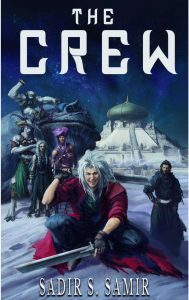 In The Crew, Edgar, former spymaster of Akrab, is on the run from the Bone Lord of Akrab, Clea. She’s ordered his death, has lost control of the city and the rising tensions between the human and demon population, is about to go bankrupt, and the only way he can see to save his beloved city is to remove her, despite his feelings for her. He needs a crew. One that makes use of the natural-born, manufactured, and imbibed power of the people of the land. And his starting point is Varcade, an ex-Educator and semi-superhuman mercenary. From there, along this crazy, exciting, non-stop journey to the heart of Akrab we meet dusters (humans who snort the ground bones of dead gods to gain magic powers) who have become dogs, fly on clouds, and are made of smoke, a necromancer who loves detonating bodies, an old lady with a wicked judo chop, demons of every size and shape you could imagine, and a crazily vast range of characters as diverse as a toad is from a human and everything in between.
In The Crew, Edgar, former spymaster of Akrab, is on the run from the Bone Lord of Akrab, Clea. She’s ordered his death, has lost control of the city and the rising tensions between the human and demon population, is about to go bankrupt, and the only way he can see to save his beloved city is to remove her, despite his feelings for her. He needs a crew. One that makes use of the natural-born, manufactured, and imbibed power of the people of the land. And his starting point is Varcade, an ex-Educator and semi-superhuman mercenary. From there, along this crazy, exciting, non-stop journey to the heart of Akrab we meet dusters (humans who snort the ground bones of dead gods to gain magic powers) who have become dogs, fly on clouds, and are made of smoke, a necromancer who loves detonating bodies, an old lady with a wicked judo chop, demons of every size and shape you could imagine, and a crazily vast range of characters as diverse as a toad is from a human and everything in between.
What The Crew has in spades is wild imagination. Demons, dusters, people who look like animals, a past war between said demons and humans and the uneasy peace ongoing, toads for steeds, and so many other really cool things packed into the story. The magic system is absolutely next level–it’s hands down my favourite part of the book (except for this one scene where I lost it laughing while on a bus home from the Sydney CBD, but I’ll get to that later) and worth picking this book up just for that.
The history of the land and the Educators I thought were really cool and well done. Despite some of the things that I wasn’t in to, that I’ll detail further in, these landed right in my enjoyment sweet spot. Using Vashi (Varcade’s brother) to showcase the thought process of the Educators was excellent (and got a few grins out of my grumpy self), and while I’m not really sure Vashi needed to get as much screen time as he did to tell the story, this is a book that’s about entertaining you like a good popcorn action movie, and that’s where I found his value.
Having said that, there are a range of things about this book that didn’t land with me. Based on seeing some of the other reviews out there about this book, there is a decent chance that I just don’t share a sense of humour with the author, and that I am potentially not the reader the author will be targeting. As a lover of Kings of the Wyld and the Deadpool franchise (from loving the movies, to screaming at the ceiling when I accidentally ruined my first Ed., first print comic as a teen) I wish these things had worked for me, but they didn’t.
Firstly was our primary badarse, Varcade. As the Deadpool-esque character his flippant approach to every mission situation just felt like a lack of effort in planning and lack of depth, and the merc with a mouth’s humour just didn’t land with me. In fact, the part I referred to earlier where I was in tears laughing on the bus home from the Sydney CBD after work like some kind of maniac (a brilliant scene with a cheeky wizard dog and some arrogant soldiers) had Varcade sidelined for most of it. For the first 10% of the book I wasn’t really sure what we were achieving, apart from making sure we knew Varcade was an epic badarse with two swords and a dark history … and that didn’t help it get off to the flying start it needed.
The mixing in of modern colloquialisms to a medieval fantasy world also just doesn’t work, for me. This is a massive personal choice here; I would hold this against me more than the author. It’s a fantasy world, the author can do whatever he wants, but things like holding out a fist and asking a medieval city person to “bump it” to seal an agreement, and some of the other modern colloquialisms used, really broke my train of concentration every few pages.
I do also need to flag for our readers that the eARC I received had spelling and grammar errors throughout that I hope will be fixed for the general market release (eg. I’m pretty sure that at some point there was a select all and replace done which switched every instance of “off” to “of”). There is also consistent telling as opposed to showing. I recognise there is an argument for both styles of storytelling–hell, I’ve made it many times when reviewing Warhammer 40K books which are renown for taking elephant sized info dumps on readers which I am totally okay with–and that’s perfectly fine, but for some reason when it’s done in fantasy it just doesn’t work for me.
Adventure fantasy fans will likely enjoy The Crew, as may die hard Deadpool fans with a different sense of humour to me. While The Crew has things in it that weren’t my jam, they may very well be yours. I encourage you to give it a try and see if it works for you, because I know there is a decent amount of people out there who are going to have a rip-snorting time laughing their arse off the whole way through.
Read The Crew by Sadir S. SamirThe post REVIEW: The Crew by Sadir S. Samir appeared first on Grimdark Magazine.
REVIEW: Loki by Melvin Burgess
Melvin Burgess’ Loki is a grown-up take on Norse mythology. This Loki is a sassy, dirty-talking god who is determined to tell his own story. Part fictional autobiography, part oral story-telling in written form. In that, it is somewhere in between a traditional novel and a compendium of stories. Burgess has been writing for a YA audience for decades, but this is his first foray into writing for an adult audience – and it is an ambitious one. I feel that you can read Loki both from start to finish and consider it one story, or pick it up again and again, reading a bit at a time and taking out individual stories.
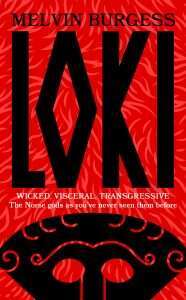 There is no shortage of fictional versions of the trickster god these days. Just within the last few years we’ve had Marvel’s TV show, Neil Gaiman’s Norse Mythology and even Louie Stowell’s middle grade Loki. So why pick up Melvin Burgess’s Loki over all of these others? Well, given that you’re reading this on Grimdark Magazine, I’m assuming that you enjoy a good dose of grimdark in your reading. And this is the most grimdark take on Norse mythology I’ve read. Not just in the way that the characters in the story are morally murky and keep betraying each other – that is a given considering the subject material. But I found that the tone and writing style Burgess used in Loki was also very similar to that of modern grimdark fantasy and I believe that this will resonate well with readers of the genre despite its more mythological grounding.
There is no shortage of fictional versions of the trickster god these days. Just within the last few years we’ve had Marvel’s TV show, Neil Gaiman’s Norse Mythology and even Louie Stowell’s middle grade Loki. So why pick up Melvin Burgess’s Loki over all of these others? Well, given that you’re reading this on Grimdark Magazine, I’m assuming that you enjoy a good dose of grimdark in your reading. And this is the most grimdark take on Norse mythology I’ve read. Not just in the way that the characters in the story are morally murky and keep betraying each other – that is a given considering the subject material. But I found that the tone and writing style Burgess used in Loki was also very similar to that of modern grimdark fantasy and I believe that this will resonate well with readers of the genre despite its more mythological grounding.
I found it compelling and funny – truly hilarious – at times. Mythology has a lot of humour to it, and Burgess makes the most of those elements. His Loki doesn’t feel like a powerful god, but rather like a flawed being trying to make the most out of the situations and life he has in front of him. His Aesir and Vanir are complicated and complex families. And Burgess leans into the queer elements present in the traditional stories and expands on them, makes them a focus of his retelling. While this isn’t a perfect book, it is one that I really enjoyed. It is a fresh take on Norse mythology and one that I expect will resonate well with readers of this site. Loki can be seen to have some structural weaknesses as a whole through its close first person narration over a long period of time, which made it feel more loosely connected than a traditional plot, though it felt very intentional on the author’s part. I am mainly flagging it here for readers who may not care for experimental story-telling as much – though I found it did work well here. Loki charms his way into readers’ hearts again and again, whether they want him to or not.
Read Loki by Melvin BurgessThe post REVIEW: Loki by Melvin Burgess appeared first on Grimdark Magazine.
November 28, 2022
REVIEW: The Adventures of Amina al-Sirafi by Shannon Chakraborty
Some books are so magical you know within a few pages that they will end up on your favourites shelf. The Adventures of Amina al-Sirafi by Shannon Chakraborty is such a book. I was smitten by the end of the historical preface, in love by the time I first got to glimpse Amina herself. Shannon Chakraborty wrote herself into readers’ hearts with the Daevabad series – fans will spot a fun easter egg in this – but has seriously levelled up with this new book. Telling the magical tale of Amina al-Sirafi, medieval pirate in the Pacific within the historical context of the Crusades and Holy War, this is compelling, twisty and brilliant.
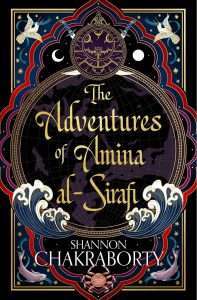 When we meet Amina, she has long since retired from her life at sea. Settled down to give her daughter, Marjana, a good life, she is neither young nor beautiful anymore – a rare thing for a heroine these days. It is great to read a book about a middle aged heroine, driven by her personality rather than her looks, with the latter not really playing much of a role at all. But then, a rich woman makes Amina an offer she can’t refuse. Her granddaughter has been kidnapped by a Western treasure hunter, remaining in the region after coming as part of the Crusades. But not all is quite what it seems and everyone has far more complicated motivations for their actions than it first seems. I also appreciated how romance – or maybe more accurately, seduction – is used as a tool rather than as a primary focus of the story, a minor element but not something that is dominant. The love of friendship and family, both family by blood and family by choice is far more important here.
When we meet Amina, she has long since retired from her life at sea. Settled down to give her daughter, Marjana, a good life, she is neither young nor beautiful anymore – a rare thing for a heroine these days. It is great to read a book about a middle aged heroine, driven by her personality rather than her looks, with the latter not really playing much of a role at all. But then, a rich woman makes Amina an offer she can’t refuse. Her granddaughter has been kidnapped by a Western treasure hunter, remaining in the region after coming as part of the Crusades. But not all is quite what it seems and everyone has far more complicated motivations for their actions than it first seems. I also appreciated how romance – or maybe more accurately, seduction – is used as a tool rather than as a primary focus of the story, a minor element but not something that is dominant. The love of friendship and family, both family by blood and family by choice is far more important here.
We spend most of the story with Amina and her motley crew of sailors, reassembled by necessity. Shannon Chakraborty weaves in mythology, history and brilliant characters with an adventure story to create a plot that is also, most of all, fun to read. Two things that particularly stood out to me as wonderful devices of her craft were the weaving in of stories, using the past as something of a mythologised tale to create a larger-than-life version of Amina as well as the nuanced treatment of queer characters within the historical and religious context of the story. There are multiple characters that identify on the queer spectrum, and I loved discovering their identities as the story went on – and found that it added a layer of joy to the story that I didn’t expect.
The Adventures of Amina al-Sirafi is a masterpiece and a must-read for those who enjoy historical fantasy, brilliant characters and great storytelling. Oh, and I guess there’s pirates, daeva and other supernatural creatures too. And a good dose of fun and betrayal. Five stars for a firm favourite.
Read The Adventures of Amina al-Sirafi by Shannon ChakrabortyThe post REVIEW: The Adventures of Amina al-Sirafi by Shannon Chakraborty appeared first on Grimdark Magazine.
November 27, 2022
REVIEW: Star Wars: Andor
Disney’s stewardship of the Star Wars brand has been somewhat spotty in its handling. I’m going to spare you my opinion on the subject because we would be here all day but I was a Legends fanboy and religiously cultivated my love of the Expanded Universe for a good ten to twelve years of my life. Suffice to say, my opinion of the sequels was less than stellar and I feel like with the exception of Lost Stars, the novels have been nothing of particular note either. Thankfully, Disney has been doing somewhat better with the television shows as both The Mandalorian and Kenobi were pretty good. I’d even go so far as to say that Kenobi should have been a movie in theaters rather than on Disney+.
Andor, by contrast, is its own beast and I honestly think it may be among the best Star Wars media ever created. I bring up all of my above Star Wars experience because I’m putting that into context. I’ve read everything from The Lost City of the Jedi to the New Jedi Order. I’ve watched Droids, Ewoks, Clone Wars, and Resistance. I can tell you the difference between a Quarren and a Klantooine. What I’m saying is I know shit.
I don’t know if Star Wars: Andor justifies the existence of Disney’s Star Wars but it is a compelling argument by itself. The Mandalorian is what I wanted from a Boba Fett series since I was eight years old but Andor does something different. Andor is actually of artistic merit. That’s a bit of a loaded pair of buzzwords but it’s the best way to describe what this show does for me. There’s nothing wrong with entertainment that exists to entertain but Andor manages to do that while also actually having something to say. A lot of things to say actually. All of which it does with imagery, storytelling, and strong characters.
The funny thing is that I was going to give this one a pass. I mean, who the Nine Corellian Hells cares about Cassian Andor? He was okay in Rogue One but it’s not like he was a particularly important character that I was dying to learn more of. If I had to choose any character from the Disney movies I would want to watch a series about, I’d probably choose Jyn Erso, Rey, Finn, Rose, Q’ra or Tobias Beckett. Hell, I’d watch an office comedy starring Admiral Krennic. Not that I was dying for any of these movies but Cassian didn’t leave much of an impressive. Here, he does.
Getting into the actual review, Andor is ostensibly the story about the titular character. It’s not quite twenty years into the reign of the Empire and he’s a petty thief working on the planet Ferrix as he’s struggling to find his lost sister. Cassian is an indigineous native of a planet that got separated from his family due to the Clone Wars and thinks he can track her down. The different kind of story this show is can be summarized by the fact he looks for her in a brothel and ends up murdering two cops, one of them begging for his life, in the first five minutes.
Now that might give you the impression this is a grimdark show or ridiculously gritty but this is definitely a far more grounded show than the typical Star Wars universe. This is not Luke Skywalker or even Han Solo’s Star Wars. This is maybe not even Wedge Antilles’ Star Wars, this is Uncle Owen and Rebel Soldier 271’s Star Wars. There are many people who have 9-5 jobs under the Empire, Stormtroopers are terrifying, and you can have your life ruined by an Imperial beach cop sending you away for six years for loitering.
This is the first Star Wars work to really give us an idea of what “normal” life in a galaxy far far away is like. The oppression of the Empire is everywhere but it’s just close enough to what we experience in our day to day life to be disquieting. The Empire has put the squeeze on everyone but Cassian, like many others, is determined to keep his head down until events actively prevent him from being able to do so. We get to see what life is like on worlds occupied by the Empire, how the upper crust live, the inside of a minimum security prison, and more.
Strangely, my favorite part of the story is Mon Mothma’s part. They somehow got Genevieve O’Reilly back twenty years later after only a walk on cameo for Revenge of the Sith with most of her story removed from it to reprise the character. The founder of the Rebellion isn’t doing much founding, though. Instead, she’s doing the infinitely less glamorous role of financing petty rebel cells while hoping to be able to do more. Her husband and child don’t know what she’s up to and they’re put in danger with every act she does.
This is a Star Wars show that reckons with the politics of fascism and how it is an insidious and not always overly visible force. It’s not about Darth Vader or Emperor Palpatine but the petty prison wardens and smug rent a cops who revel in the power their positions grant them. Resistance to tyranny is something that goes beyond simply shooting up baddies and it is sobering how easy it is to believe things aren’t “that bad.”
The post REVIEW: Star Wars: Andor appeared first on Grimdark Magazine.
November 26, 2022
REVIEW: Nephilim: A Behind Blue Eyes Origins Story Vol. I-III by Anna Mocikat
Nephilim: A Behind Blue Eyes Origins Story volumes I through III by Anna Mocikat is a trilogy of prequel novellas for her wildly entertaining Behind Blue Eyes series that I’ve been reviewing as they’ve come out. The main series is a fantastic cyberpunk series that I absolutely love and have devoured every installment of so far. They are about a bunch of cybernetically modified corporate assassins working for the sinister Olympias Corporation.
 When the author, Anna Mocikat, announced she was doing a prequel series around its protagonist, Nephilim, I was extra excited. Reading the first novel, I found it was a story of how Nephilim was kidnapped from her family and turned into the murderous death machine she is in the main books.
When the author, Anna Mocikat, announced she was doing a prequel series around its protagonist, Nephilim, I was extra excited. Reading the first novel, I found it was a story of how Nephilim was kidnapped from her family and turned into the murderous death machine she is in the main books.
I feel like this is a really tragic and interesting story as she is slowly taught to be a killer and indoctrinated into the poisonous Olympias Corporation ideology. Fans of the main series will also come to hate villain, Metatron, more because his treatment of the per-pubescent Nephilim now has shades of grooming since he later attempts to make her his lover. Thankfully, there’s nothing to that in the actual book-book, just him brainwashing her into a killer.
The Guardian Angel school reminded me a lot of the Black Widows’ Red Room from Marvel comic, despite including boy candidates, and that was a definite plus. I am definitely picking up more of these novellas as they come out, though. It is good for reading as both a stand-alone separate from Behind Blue Eyes and a companion piece.
Each book follows the character as she’s increasingly made more and more robotic as well as devoted to the cause of the Olympias Corporation. Despite being a profit driven entity, the company surrounds itself in ideological shields that claim they have eliminated poverty and strife while obviously lying their butts off. After all, you don’t need a cybernetic death squad to eliminate dissent if you’ve destroyed the forces that divide us.
Despite using the auspices of a coming of age drama and large sections of the story taking place from the perspective of an adolescent to teenage Nephilim, they are not children’s books but really a dark and twisted story of indoctrination. It deals with adult subject matter like sexuality, fascism, authoritarianism, and cults of personality. At several points, child characters do not make it to adulthood and our young heroine must simply soldier on.
I really enjoyed these three books even as sometimes the points they raise made me squirm. Cyberpunk is a genre meant for social satire and not just mirror shades as well as motorcycles. This had elements that reminded me of the movie Soldier starring Kurt Russel, Ender’s Game, and the works of both George Orwell as well as Aldous Huxley. Anna does a great job of making her handlers sound reasonable even as what they’re teaching is objectively insane. It’s a delicate balance and she threads the needle nicely.
Nephilim: A Behind Blue Eyes Origin Story can be read before or after the main series or even independently. The writing may not be for everyone as the early parts have a simplified writing style to reflect the naivite of our heroine as a child but gradually becomes far more complex.
Each book contains subject matter that some people may find controversial but nothing that isn’t found in, say, The Hunger Games. Which if you’ve read that series properly isn’t much of a defense. It’s not YA but people who like the darker of that genre will enjoy this as well as adults. They’re easy reads too and can be read separately or one after the other.
Read Nephilim: A Behind Blue Eyes Origins story by Anna MocikatThe post REVIEW: Nephilim: A Behind Blue Eyes Origins Story Vol. I-III by Anna Mocikat appeared first on Grimdark Magazine.
November 25, 2022
Grimdark Magazine Issue #32 is here, featuring Polansky, Reid, Bacigalupi, and Dalglish
After a two month run-in with the Kindle publishing team, we are finally LIVE! I’ve just been dying to get this out to you. It’s Beth Tabler’s first issue in complete control of Grimdark Magazine’s quarterly publication, and she has completely smashed this issue. I can’t wait for you to read it!
GdM #32 cover revealBased on Daniel Polansky’s Sticks and Stones Carlos Diaz has absolutely fucking smoked this cover! For Beth’s first issue, it probably has one of my favourite covers we’ve published.
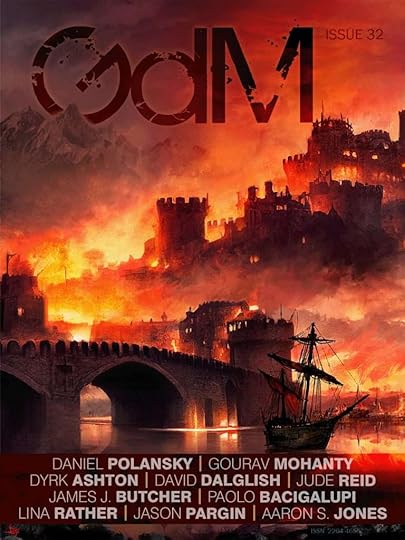
Grimdark Magazine presents the darker, grittier side of fantasy and science fiction. Each quarterly issue features established and new authors to take you through their hard-bitten worlds alongside articles, reviews and interviews. Our stories are grim, our worlds are dark and our morally grey protagonists and anti-heroes light the way with bloody stories of war, betrayal and action.
FICTIONSnow White, Green Mantle by Jude ReidBaby Teeth by Lina RatherPop Squad by Paolo BacigalupiA Place Where Stars Should Not Be by David DalglishSticks and Stones by Daniel PolanskyNON-FICTIONAn Interview with James J. ButcherMen and Monsters by Aaron S. JonesReview: The Two Doctors Górski by Isaac FellmanAn Interview with Gourav MohantyReview: The Golden Enclaves by Naomi NovikA Future Without Fiction: Dragons and Books Bans by Jason (David Wong) ParginAn Interview with Dyrk AshtonReview: A Gamble of Gods by Mitriel FaywoodSubscribersFor our loyal and wonderful Patreon subscribers, please refer to our Patreon post here to download your issue release files in mobi, ePub, and PDF.
Read Grimdark Magazine Issue #32Prefer PDF or ePub? Purchase from our webstore, here.
The post Grimdark Magazine Issue #32 is here, featuring Polansky, Reid, Bacigalupi, and Dalglish appeared first on Grimdark Magazine.
Where to start reading grimdark, no matter the genre you prefer
Depending on where you get your data from, there are up to four million books published every year. Let that sink in. Four fucking million. Add to that there are so many opinions on what sits in what genre that just getting started reading grimdark and dark SFF must seem like that episode in Squid Game where you have to jump onto one of two tiles and you have a 50/50 shot at falling 30 metres onto concrete, or living to jump onto the next pair of tiles. Everyone is shouting “read my book!” or “read this book!” and with really cool covers on just about everything these days, I can see why it’s almost impossible to know what you’re going to enjoy reading.
This is why you’ve come to Grimdark Magazine, home of the most trustworthy and non-betraying or treacherous people and characters in genre fiction who definitely won’t ever steer you astray!
Now that I’ve had my fun with the preamble, let’s get to the point. THIS, friends, is a listicle of listicles. Yes, we’ve hit peak listicle, and we’re doing it so that you can pick a genre / sub genre and get an instant list of recommendations for dark and grimdark SFF in those genres / subgenres that our team loved.
Grimdark / dark fantasyOur bread and butter. The fiction that is the reason that Grimdark Magazine was started in the first place. Where Glotka tortures you, Cersei makes you like and respect the unlovable, and Jorg gives you a really good look into the darkness.
Check out:
Grimdark Fantasy: Where to start readingFive female authors smashing grimdark fantasy right nowTop 10 standalone grimdark novels (may include some SF)Ten indie grimdark novel recommendations (may include some SF)Ten queer books to kickstart your reading (includes SF)Grimdark Top 15: James picks his favouritesTop ten Mark Lawrence short storiesFive tor.com com novellas to help you fall in love with shorter booksThe GdM team pick their favourite self-published fantasy booksCyberpunk and SFThe ugly older brother of grimdark / dark fantasy. He’s mean, he’s got a bad attitude, and he smells of cigarettes and cheap booze. He also firmly believes humankind is being crushed by powerful government overlords, but one spark of human spirit can spark a revolution, or a horrible war that kills a lot of people. Either way, it’s going to be a ride.
Check out:
Cyberpunk: Where to start reading12 SF must reads for grimdark fansEight indie cyberpunk recommendationsAnother eight indie cyberpunk recommendationsLGBTQIA+ Dark SFF character: Where to start readingMilitary science fantasyFor me, there is no better military science fantasy series out there than the Warhammer 40k universe. You could probably never read another non-40k book in your entire life, and you’d still struggle to finish them all. But, getting started in such a vast and well established universe can be daunting, so let me guide you through the best starting points so that you can get into the universe without getting overwhelmed.
Check out:
Warhammer 40K: where to start readingThree books to get you stuck into Warhammer 40,000HorrorIf cyberpunk is grimdark’s dodgy older brother, then horror is that other sibling that dresses in black and was born with an intense thousand-yard stare that your uncle had a quiet chat with your mum about last Christmas. Now, because horror translates to a lot of mediums better than some of the other genres in this list, I’ve included video games and movies in this section.
Check out:
The top ten scariest books according to a horror loverTop five slasher video gamesTop ten slasher moviesTop 5 zombie video gamesVampiresCharacters that bridge the gap between monster and human, vampires are one of the most awesome, notorious, and interesting dark characters out there. Whether they be suave and classy, or rabid and mentally unhinged, or anything in between, vampires will forever be characters that grimdark fans want to read about. I’m actually a little shocked we only have one article on the topic!
Check out:
Vampire fiction that doesn’t suck: Where to start readingHistorical fictionIt’s often said that no fiction can be as grimdark as actual human history. A quick look through our species’ history probably won’t disabuse you of that notion. And while historical fiction lacks the SFF elements we love, it’s still brutal AF and we love it.
Check out:
6 historical fiction books for grimdark fansFree readsLet’s face it, most of GdM’s readership live in societies where you can’t turn left without getting charged $1.99 for the privilege. Sometimes, either because we’re a bit skint or we just don’t want to get the wallet out AGAIN, it’s nice to get a really good quality read for free. Here’s how you can do that without resorting to stealing (and yes, downloading ebooks from pirate sites is stealing).
Check out:
Where to read your favourite authors for free (without being a pirate bastard)The post Where to start reading grimdark, no matter the genre you prefer appeared first on Grimdark Magazine.
An Interview With Dyrk Ashton
Not long ago I was recommended the Paternus series by a good friend. It had been my first foray into the wild world of self-published fantasy. To say that Paternus by Dyrk Ashton is one of my favorite series is an understatement. Paternus is a great read from start to finish. It has excellent pacing, magnificent action and humor. It shows just how incredible self-publishing really is.
I had the great honor of interviewing Dyrk this month, and hopefully some of you will give the Paternus universe a swing.
[GdM] You’ve been deeply involved in the film industry; where did you get your start?

[DA] I developed a love of movies at a young age and in high school started to think I wanted to be a filmmaker. When college rolled around I went for something that made more practical sense and studied business for my first two years. While in college my first year I met a few of the filmmaking students at Ohio University and helped them with one of their projects and loved it. I stuck out a second year studying business, this time at the University of Toledo, after which I was convinced a career in business wasn’t what I wanted to do with my life. I transferred to the film program at The Ohio State University, where I got my bachelors in film and video production, and stayed for my masters, during which time I produced the first feature length film that had been done within the department. That was an ultra low budget but kind of arty horror film called Beyond Dreams Door, which was actually picked up for distribution on video.
While going to film school I worked as a production assistant on locally shot commercials and industrial films, and worked my way up to grip, then did some assistant directing, and ended up mostly production managing and producing. After school I kept at that while working on low budget creative short films and a feature film, and some friends of mine and I started our own production company. After a time I moved to Los Angeles where I worked on shoot in about every capacity you can imagine while writing and submitting screenplays, none of which really went anywhere, though I did have some read by Scott Free Entertainment and New Line Cinema and had a TV series proposal championed by American Zoetrope Television, which was later turned down by the financiers.
Oddly enough, the vast majority of my income in Los Angeles came from acting. I’m a terrible actor, but really good at auditioning. I don’t know if I can call it a start, but the first professional “acting” gig I had was years before I’d gone to L.A., as the Truck Zombie in the 1990 remake of Night of the Living Dead.
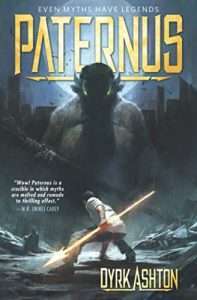 [GdM] In what way do you think your background in films has helped you craft stories? Is there a way that it has hindered you?
[GdM] In what way do you think your background in films has helped you craft stories? Is there a way that it has hindered you?
[DA] My background in film has definitely had a huge influence on my writing, from the way I plot and structure to how I begin and end chapters and the way I use tense and POV. That comes from directing and editing as well as screenwriting. The only thing I can think of that hindered me was it took me a long time to figure out how to tell stories with a lot more words than you do with a script.
[GdM] Did you find yourself sketching and approaching scenes the same way a cinematographer would? I noticed this was especially true of the fight scenes in the novel.
[DA] I’m a TERRIBLE artist so I didn’t sketch, but I definitely use a filmmaker’s approach to envisioning the space and movement within a scene while I write. When writing I know that I’m always as least half conscious of the angle and shot on the character, even if I don’t describe it. Basically I’m choosing camera angles, shot size, camera movement, and character blocking all the time.
[GdM] I need to know how you have written so many books. Every great series that has ever been written and will be written will have the name Dyrk Ashton attached.
[DA] It’s a hard life, or at least started that way. It began when Michael R. Fletcher stole my pants then locked me in a cage in his basement and made me write all of his earlier books. Then I escaped and put him in the cage, then kidnapped Rob Hayes and put him in there, and made both write books for me. I’ve added about two dozen authors since. At this point I don’t even know which ones I write myself or under their names anymore. Sigh.
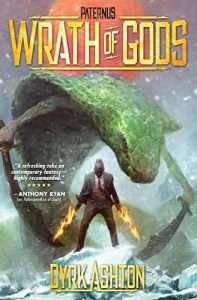 [GdM] How did Wizards, Warriors, and Words come about?
[GdM] How did Wizards, Warriors, and Words come about?
[DA] That was all Jed Herne. He contacted me, Mike Fletcher and Rob Hayes (which wasn’t hard, since they’re in my basement), and asked if we want to give it a shot and see how it went after a few. I honestly don’t know how it happened, but now we’ve been doing it for two years and have over a hundred episodes! Really, though, it’s really weird to look back and realized we’ve come that far.
[GdM] How has the book community on Twitter helped and hindered your writing?
[DA] The only thing that hinders my writing is me. I’m really a sloth in a Fletcher skin suit. The Twitters have been truly great. I believe a very large number of my readers would never have heard of the book without all the wonderful folks there.
Is there a particular example of a piece of writing you discovered just how powerful the written word could be?
[GdM] What was the original nugget of an idea that Paternus is based on?
[DA] Two old goofy ideas, really. One was about a group vampires who though thtye were ancient and powerful, until they ran into some much more ancient and powerful, and so on, until they find out there’s the original vampire that had been watching them all, wipes them all out and starts over again. I think I was twelve when I came up with that. It evolved over the years, thank gods.
The second was I love mythology and always toyed with the idea of making up a kind of unified field theory for mythology that would tie them all together, traced back to where they came from and what really happened that spawned them all. Taking very loosely from those two ideas germinated the starting point for Paternus.
[GdM] How did you plan such a detail-oriented story? Are your walls covered in post-it notes?
[DA] I have literally HUNDREDS of pages of notes and enormous spreadsheets of information all put together while I was brainstorming and refining the idea and story. I probably spent a few hundred hours outlining for the three books, at least.
[GdM] Which myth did you have the most fun twisting around?
[DA] Norse Mythology, definitely. I’m not saying it’s my favorite mythology, but what I was able to do with it to serve the story and worldbuilding was really, really fun.
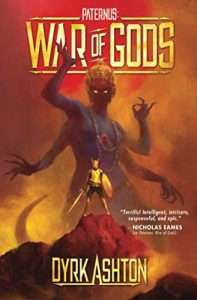 [GdM] Are there any “darlings” that you would have loved to have had in the story had they worked?
[GdM] Are there any “darlings” that you would have loved to have had in the story had they worked?
[DA] Not sure what the question is exactly, but I’ll assume this is about myths; stories from myths or characters from myths. And, wow, there are SO many I wouldn’t know where to start. The hardest part of selecting characters wasn’t deciding who to put in the books and how much story importance they’d have, but having to not use so many others that I love.
[GdM] You have a rabid fanbase of myth geeks, myself included. When you wrote the Paternus series, did you know how well it would do with the reading public?
[DA] I absolutely did not. I knew the first book odd and oddly written, but I did it that way on purpose because I wanted to write the book I wanted to read. I just crossed my fingers and hoped some people would like that too. I didn’t have very high hopes, though.
[GdM] What is next? What are you working on?
[DA] Right now I’m having an absolute blast writing the first book in this crazyfarmboy-outcast-makes-good-magic-military-dragon-rider-school-epic-progression-fantasy tentatively titled Kraken Rider Z. Yeah, that 
Thank you for having me!
READ THE PATERNUS SERIES BY DYRK ASHTONThe post An Interview With Dyrk Ashton appeared first on Grimdark Magazine.
November 24, 2022
REVIEW: Jade City by Fonda Lee
Jade City is Fonda Lee’s World Fantasy Award-winning urban fantasy set in the Asian-inspired island nation of Kekon. Jade City is the nickname for Janloon, the capital of Kekon, which is controlled by mafia-style gangs led by organized crime families.
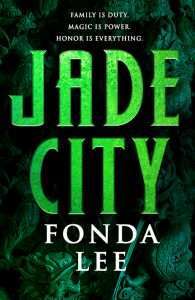 The two most prominent gangs are the No Peak and Mountain clans, who clash over control of city neighborhoods, but more importantly over the mining and trade of Kekonese jade. When worn by someone with the appropriate training and genetic predisposition, jade gives the wearer enhanced abilities in fighting and perception. A newly developed drug called SN1 (or “shine”) can extend these abilities to non-Kekonese people, enabling the use of jade as a dangerous new weapon at a global scale. The combination of jade and shine offers a short-circuit path to power and has led to the illegal production and trade of both substances.
The two most prominent gangs are the No Peak and Mountain clans, who clash over control of city neighborhoods, but more importantly over the mining and trade of Kekonese jade. When worn by someone with the appropriate training and genetic predisposition, jade gives the wearer enhanced abilities in fighting and perception. A newly developed drug called SN1 (or “shine”) can extend these abilities to non-Kekonese people, enabling the use of jade as a dangerous new weapon at a global scale. The combination of jade and shine offers a short-circuit path to power and has led to the illegal production and trade of both substances.
The three main characters in Jade City are the Kaul siblings, who have inherited control of the No Peak clan from their grandfather. The eldest, Lan, is the Pillar (leader) of the clan and struggles to provide strong leadership while dealing with several personal issues. Hilo is Lan’s fiery younger brother who serves as the Horn (chief fighter) of the clan. Hilo is impulsive and quick-tempered, but he has absolute loyalty to his family. The third principal character, Shae, is their younger sister who has just returned to Kekon after completing her education abroad. Shae struggles to discern her future, trying to balance her family’s expectations with finding her own path.
Fonda Lee brilliantly captures the intersecting web of conflicts experienced by the main characters. Inter-generational conflict within the No Peak clan arises between the young generation of the Kaul family and their grandfather, who still wields substantial behind-the-scenes authority. There is also sibling infighting among Lan, Hilo, and Shae, whose family loyalty often manifests itself in divergent ways owing to their very different personalities. Of course, the most violent rivalry occurs between the No Peak and Mountain clans. Jade City also hints at the conflict between Kekon and foreign countries, which will become a major focus later in the series.
Fonda Lee adopts a fully immersive approach to worldbuilding in Jade City. This is a bit disorienting at first but soon rewards the reader, pulling them into the story. Jade City has a cinematic quality that reminds me of watching The Godfather or Goodfellas. Fonda Lee’s writing is so captivating that, as a reader, I felt like an extra on the set of a movie, watching the action up-close.
Speaking of action, Fonda Lee is especially adept at writing fight scenes. As a black belt martial artist, the detail that Fonda Lee brings to these sequences makes them feel especially realistic. Moreover, the enhanced abilities provided by jade remind me of the best fight scenes from Hong Kong and Taiwanese martial arts movies. The emotional intensity of these action sequences is matched by several heartbreaking scenes throughout the novel.
Jade City is a breathtakingly original, pulse-pounding urban fantasy and a triumph in every sense. Jade City is the first book in Fonda Lee’s Green Bone Saga, which continues with Jade War and Jade Legacy.
5/5
Read Jade City by Fonda LeeThe post REVIEW: Jade City by Fonda Lee appeared first on Grimdark Magazine.
November 23, 2022
An Interview With James J. Butcher
James J. Butcher, son of famous New York Times bestselling author Jim Butcher has entered the urban fantasy world with his exciting new novel Dead Man’s Hand. Dead Man’s Hand is the story of Grimshaw Griswald Grimsby, flunked auditor and mediocre witch. When a murder takes place down the road from him that puts his freedom in jeopardy, he needs to use his wits, a strange and unlikely alliance and not a small amount of luck.
James was kind enough to sit down with me for a little chat about writing, fantasy, and his unlikely hero Grimshaw Griswald Grimsby.
[GdM] Is there a story that was very influential for you? If so, how?

[JJB] It’s been repeated a lot, but of course it’s Tolkien: “All that is gold does not glitter, Not all who wander are lost.”
More than one, certainly. Growing up, I was rarely without a book in hand, especially during school. I was thoroughly entrenched in the Harry Potter generation, but I also enjoyed Eragon, and a good deal of Garth Nix stories. As far as television goes, Avatar the Last Airbender is one of the finest stories I’ve ever consumed in any medium.
[GdM] Along the same lines, it is safe to say that you come from a household steeped in books. Is there a passage or quote from a novel that you found particularly powerful?
[JJB] I’ve been wandering through stories my whole life, and stories are where I feel the least lost.
[GdM] What attracts you to urban fantasy as a genre?
[JJB] Urban fantasy is quite unique amongst fantasies, as it allows for incredibly dense stories. Most fantasy requires a great deal of explanation and translation for readers. After all, they’re learning an entirely new world. But urban fantasy is just our world… but more interesting. You can safely gloss over boring topics and trust the reader will simply assume it’s something they’re familiar with, leaving the writer with more time to focus on the fun stuff.
[GdM] Can you tell us a bit about Dead Man’s Hand?
[JJB] Dead Man’s Hand is the first in the series of stories about Griswald Grimshaw Grimsby, a witch of mild disposition and milder talent in a world that is somewhat darker than he realizes. Magic not being his strongest weapon, he instead has to weaponize wit, snark, and stubbornness in order to survive.
[GdM] Dead Man’s Hand has a strong horror element. Are you attracted to darker stories? Do you have a favorite?
[JJB] I like dark stories and bright characters. Without that contrast, too dark or too light, the story feels muddled and static or the characters feel bland and boring. An optimist in a utopic cityscape of peace and prosperity doesn’t stand out like they would in a dystopic wasteland full of monsters and villainy. The first character is a product of their environment, while the second is something more intriguing. So, consequently, I often find in my stories that I am putting good people in pretty awful situations.
[GdM] Authors use the expression “kill your darlings” to describe cutting an unnecessary storyline, dialog, or character. Did you have anything in Dead Man’s Hand that you had to cut? Or that we may see in future books you can tell us about?
[JJB] I did indeed. The initial draft of the story had two back-to-back chapters for the secondary character of the story, Leslie Mayflower. Unfortunately, these chapters were also the very first two in the story, leading readers to believe that Mayflower was the protagonist, not Grimsby. It led to a surprising shift when the tone went from hard-bitten veteran to naïve novice and stayed that way for quite a while. Fortunately, I simply trimmed those chapters down into a single section, relabeled it as a prologue, and the issues were largely resolved. Unfortunately, I had to delete a scene I quite enjoyed, but I’m sure it will find its way into the next book instead.
[GdM] All authors work differently. What was your process when you began to craft Dead Man’s Hand? Did the magic system come first, or was it the protagonist, Grimshaw Griswald Grimsby.
[JJB] The relationship between Grimsby and Mayflower is actually what came first. The characters changed several times in the earliest versions of the stories, one of which was set in the 1930’s, but who they were to each other never changed.
The relationship was a hybrid of buddy-cop-duo and mentor-mentee that is no doubt drawn from the most important relationships in my own life. For a long time, I wrote stories with loner characters which, as an only child and somewhat isolated individual, I was more comfortable with. But I found the stories dull and droning. It was until I started focusing on the ties, and the wedges, between different characters that I really felt like my stories started becoming engaging.
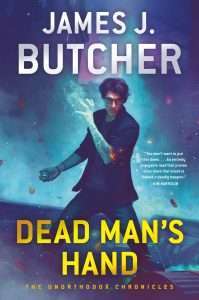 [GdM] Could you tell us about the characters Grimsby, and The Huntsman and their relationship? They both seem like they are at their lowest coming into the story.
[GdM] Could you tell us about the characters Grimsby, and The Huntsman and their relationship? They both seem like they are at their lowest coming into the story.
[JJB] Their relationship is basically the story, or at least the central part of it. They are both broken, but in very different ways. Mayflower for the things he has lost, and Grimsby for the things he never had. But while they are both missing important pieces of themselves, they have surpluses in other areas that they begin to use to support each other, giving one another the solid footing they both need to start putting themselves back together.
Oh, and they aren’t at their lowest. Not yet, and not by a long shot.
[GdM] Grimshaw Griswald Grimsby is an unusual name for a character. How did you come up with it?
[JJB] Indecision, mostly. Grimsby in particular was a name I knew I wanted to use, ever since I first heard it on a history podcast about World War I. However, Grimshaw and Griswald were both first names that I agonized over for a long time before deciding that I really liked them both. I then realized the only rule saying I had to pick one was one of my own design, so I scrapped the rule instead of a name. But, to make up for the absurd name, I decided I would need an equally absurd character, just in the opposite direction. Grimsby needed to be the total and utter opposite of badass and work his way to earning his name. I used the same rule for Leslie Mayflower, but inverted. He couldn’t be as competent as he is and still have a cool name.
[GdM] I am fascinated by the concept of Elsewhere and masks that witches wear to protect themselves from seeing it. How did you come up with that idea? Will we get to read more about Elsewhere and masks protecting witches in future books?
[JJB] The initial concept came from Superman. Clark Kent isn’t much to write home about, but he takes his glasses off and becomes something else entirely. I wanted witches to have that same feeling, but with the risks and dangers that are implicit in modern magic settings.
That eventually mixed with another problem I had: over-description. I love to wax over irrelevant things like architecture and scenery and epic, absurd settings, but there simply isn’t space in an urban fantasy story for all that. That’s where I came up with the Elsewhere: a place where I could go crazy, putting in whatever cool nonsense I could imagine, and still keep it confined to smaller portions of the story and not bloat my wordcount and eat up my readers’ time unnecessarily.
Then, to mix them, all I had to do was fill the Elsewhere with monsters and have masks be the only thing between them and witches, and then have witches be the only thing between the monsters and the Usuals.
[GdM] The magic system for The Unorthodox Chronicles is unique. You have the ordinary Usuals and the paranormal Unorthodox. The Unorthodox are witches that use magic, sometimes powerful, and sometimes just useful. Did you research different magic systems? Was there anything that you read that inspired the Unorthodox magic system?
[JJB] This one’s a bit involved.
One of the classic elements of urban fantasy is the liminal aspect of the paranormal world. The idea that all these fantastic and wondrous things are real, but most folks don’t have any clue about them. Frankly, I got bored of that. It felt like an excuse to not deal with the overarching impact that freakin’ magic being real would have on practically everything. So, I decided I was going to write a story where everyone knew magic was real.
And boy, was it hard.
I realized that the liminal fantasy element was as much practical as traditional. It saves so, so much time for the same reason that urban fantasies can be so compact: the reader can assume a lot about the parts of the world the writer leaves blank, because they already know about them. Without this, things got more complicated very quickly, and I found that I had to narrow the scope of my stories quite a bit from my initial plans to still keep the stories fast-paced and immersive without feeling like I gloss over important world details.
This concept ended up influencing how my magic system developed. I couldn’t have it be so powerful and omnipresent that it would supplant technology, because then it’s just fantasy without the urban. But I also couldn’t have it be so small-scale that technology totally outclassed it, because then it’s urban without the fantasy. So, I needed to strike a balance. With that in mind, magic became something that was the only way to solve certain problems, but they weren’t really problems most people had, and, importantly, they needed to be problems that most people would prefer not to think about.
[GdM] What is next for you?
[JJB] That’s tough to say. I can say that there will be another Grimsby book, the first draft of which is already being churned up in the editing process. In the meantime, I’m working on another project which may or may not see completion in the future. It depends on how well I can reconcile demons and cowboys.
Read Dead Man’s Hand by James J. ButcherThe post An Interview With James J. Butcher appeared first on Grimdark Magazine.



